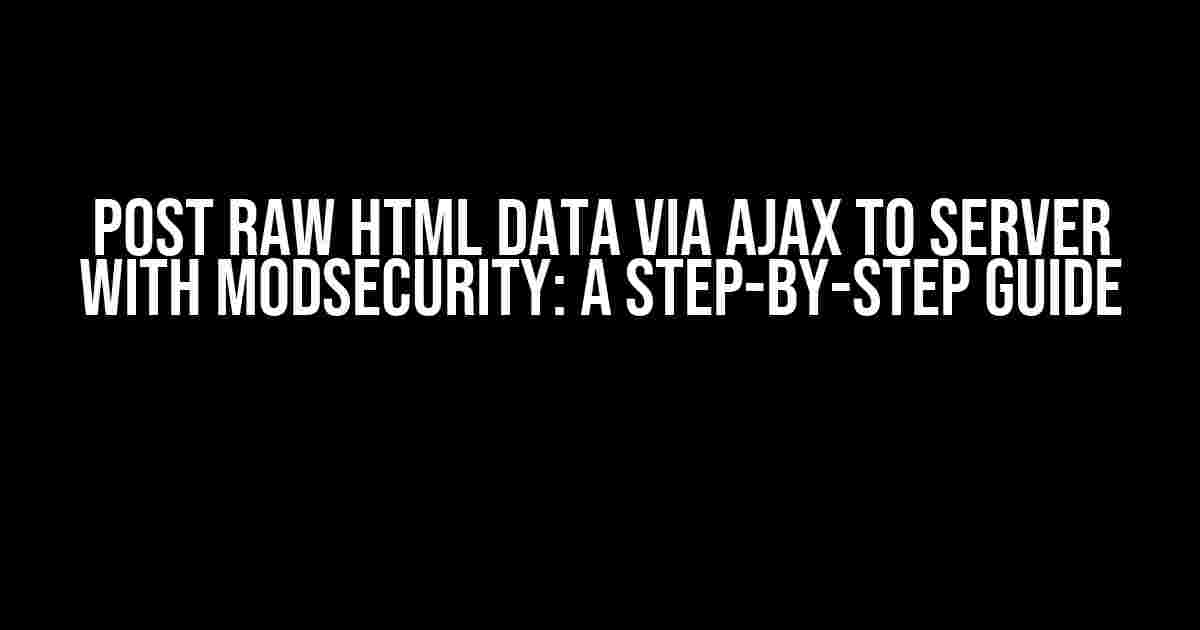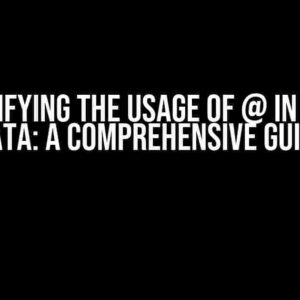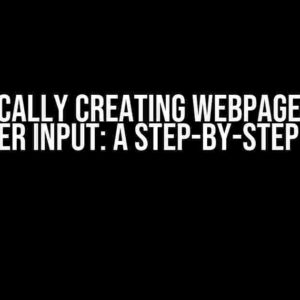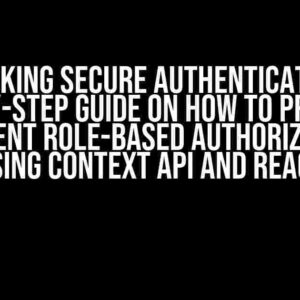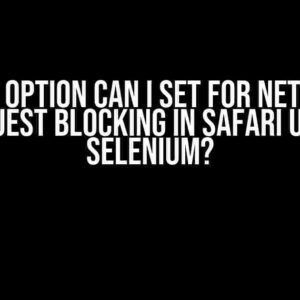Are you tired of struggling to send raw HTML data via AJAX to your server, only to be blocked by ModSecurity? Well, worry no more! In this comprehensive guide, we’ll walk you through the process of successfully posting raw HTML data using AJAX while navigating the strict security rules of ModSecurity.
What is ModSecurity?
ModSecurity is an open-source web application firewall (WAF) that helps protect your web server from various types of attacks, including SQL injection, cross-site scripting (XSS), and more. While it’s an excellent security tool, it can sometimes be overly aggressive in blocking legitimate requests, making it challenging to send raw HTML data via AJAX.
The Problem: ModSecurity Blocking AJAX Requests
When you try to send raw HTML data via AJAX, ModSecurity might block the request, citing security concerns. This is because ModSecurity is designed to detect and block potentially malicious requests. However, in this case, we want to bypass these security restrictions to successfully post our raw HTML data.
Understanding the Issue: Why ModSecurity Blocks AJAX Requests
ModSecurity uses a set of rules to analyze incoming requests. These rules are based on a complex set of patterns and heuristics to identify potential security threats. When an AJAX request contains raw HTML data, ModSecurity might flag it as suspicious, leading to a blocked request.
The Solution: Posting Raw HTML Data via AJAX with ModSecurity
Don’t worry; there are ways to overcome this obstacle. By following these steps, you’ll be able to successfully post raw HTML data via AJAX while keeping ModSecurity happy.
Step 1: Prepare Your Data
Before sending the data, make sure to prepare it properly. In this case, we’ll use a simple HTML form to collect user input.
<form id="myForm">
<label>Enter your HTML data:</label>
<br>
<textarea id="htmlData" name="htmlData"></textarea>
<br>
<button type="submit">Send Data</button>
</form>Step 2: Encode the HTML Data
To avoid ModSecurity’s wrath, we need to encode the HTML data using the JavaScript `encodeURIComponent()` function. This will ensure that the data is properly escaped and can be safely transmitted.
const(htmlData) = document.getElementById("htmlData").value;
const(encodedData) = encodeURIComponent(htmlData);Step 3: Create the AJAX Request
Next, we’ll create a JavaScript function to send the encoded data via AJAX. We’ll use the `XMLHttpRequest` object to make a POST request to our server.
function sendData() {
const xhr = new XMLHttpRequest();
xhr.open("POST", "process.php", true);
xhr.setRequestHeader("Content-Type", "application/x-www-form-urlencoded");
xhr.send("htmlData=" + encodedData);
}Step 4: Handle the Server-Side Processing
On the server-side, we’ll create a PHP script to process the incoming request. We’ll use the `urldecode()` function to decode the encoded data and then store it in a database or file.
<?php
$htmlData = urldecode($_POST['htmlData']);
// Store the data in a database or file
file_put_contents("stored_data.html", $htmlData);
?>Configuring ModSecurity to Allow AJAX Requests
By default, ModSecurity blocks AJAX requests containing raw HTML data. To overcome this, we need to configure ModSecurity to allow our AJAX requests.
Method 1: Whitelisting IP Addresses
One way to bypass ModSecurity’s restrictions is to whitelist the IP address of your server or client. You can do this by adding the following rule to your ModSecurity configuration file (usually `modsecurity.conf`):
<IfModule mod_security2.c>
SecRule REMOTE_ADDR "@ipMatch 192.168.1.100" "phase:1,allow"
</IfModule>Method 2: Disabling ModSecurity for Specific URLs
Another approach is to disable ModSecurity for specific URLs or directories. You can do this by adding the following rule to your ModSecurity configuration file:
<IfModule mod_security2.c>
<Location /ajax/>
SecRuleEngine Off
</Location>
</IfModule>Troubleshooting Common Issues
If you’re still experiencing issues, here are some common problems and their solutions:
| Issue | Solution |
|---|---|
| ModSecurity still blocks the request | Check the ModSecurity logs to identify the specific rule causing the block. You can then adjust your configuration to whitelist the IP address or disable ModSecurity for the specific URL. |
| Data not being stored on the server-side | Verify that the `process.php` script is correctly storing the data. Check the server logs for any errors and ensure that the script has the necessary permissions. |
| AJAX request not being sent | Check the JavaScript console for any errors. Ensure that the `sendData()` function is being called correctly and that the AJAX request is being sent successfully. |
Conclusion
In conclusion, posting raw HTML data via AJAX to a server with ModSecurity requires careful planning and configuration. By following these steps and understanding the underlying security concerns, you’ll be able to successfully bypass ModSecurity’s restrictions and store your raw HTML data on the server-side. Remember to troubleshoot common issues and adjust your configuration as needed.
Best Practices for Working with ModSecurity
To ensure a smooth experience when working with ModSecurity, follow these best practices:
- Regularly review ModSecurity logs to identify potential issues.
- Whitelist IP addresses or disable ModSecurity for specific URLs only when necessary.
- Implement proper input validation and sanitization to prevent security vulnerabilities.
- Keep your ModSecurity configuration up-to-date and regularly update your ruleset.
By following these guidelines and understanding how to post raw HTML data via AJAX with ModSecurity, you’ll be well on your way to creating secure and efficient web applications.
Here are 5 Questions and Answers about “Post raw HTML data via AJAX to server with ModSecurity” in a creative tone and voice:
Frequently Asked Question
Got questions about posting raw HTML data via AJAX to a server with ModSecurity? We’ve got answers!
How do I post raw HTML data via AJAX to a server with ModSecurity without getting blocked?
To avoid getting blocked by ModSecurity, make sure to set the `Content-Type` header to `text/plain` in your AJAX request. This tells ModSecurity that the data being sent is plain text and not a potential threat. You can also consider setting the `X-Requested-With` header to `XMLHttpRequest` to indicate that the request is coming from an AJAX script.
Will ModSecurity detect and block HTML tags in my AJAX request?
ModSecurity can detect and block HTML tags in your AJAX request, depending on the rules configured on the server. To avoid this, you can encode your HTML data using Base64 or URL encoding before sending it to the server. This will prevent ModSecurity from detecting the HTML tags and blocking the request.
Can I post raw HTML data via AJAX to a server with ModSecurity without encoding it?
While it’s technically possible to post raw HTML data via AJAX to a server with ModSecurity without encoding it, it’s not recommended. ModSecurity may block the request or trigger a false positive, depending on the rules configured on the server. Encoding your HTML data using Base64 or URL encoding is a safer and more reliable approach.
How can I configure ModSecurity to allow raw HTML data in AJAX requests?
To configure ModSecurity to allow raw HTML data in AJAX requests, you’ll need to create a custom rule that excludes the specific AJAX endpoint from ModSecurity’s filtering. This can be done by adding a `SecRule` directive to your ModSecurity configuration file, specifying the AJAX endpoint and the allowed request headers. Note that this requires a good understanding of ModSecurity rules and may require assistance from a qualified security expert.
Are there any alternative approaches to posting raw HTML data via AJAX to a server with ModSecurity?
Yes, there are alternative approaches to posting raw HTML data via AJAX to a server with ModSecurity. One approach is to use a JSON-based data format, such as JSON- encoded HTML, which is less likely to trigger ModSecurity’s filtering. Another approach is to use a server-side proxy or WAF that can handle the HTML data and forward it to the server, bypassing ModSecurity’s filtering.

